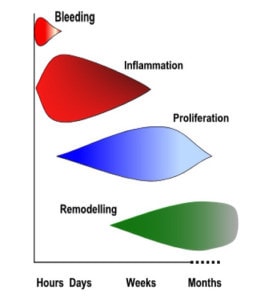The Stages Of Normal Tissue Healing
Normal Stages of Healing
Understanding how an injury heals and the stages it progresses through allows our physiotherapists at K.M. Woods Physiotherapy to accurately plan your treatment and rehabilitation to ensure the best outcome from an injury. The following is a brief overview of normal healing of soft tissue; muscles, ligaments, tendons.
Soft Tissue Injury
Initial Injury occurs which results in local bleeding, often deep under the skin. Chemical changes occur and the injured tissue clots. This stops excessive blood loss and the clot also forms the initial matrix or platform for healing. At this stage, it is important not to excessively disturb the clot or it can break up and bleeding can reoccur which will delay healing times. Thus, the first advice is “POLICE” – Pressure, Optimal Loading, Ice, Compression, Elevation. The theory of optimal loading is relatively new and has replaced the theory of total Rest. Yes, we want to protect and offload the injury but gentle movement rather than complete rest can help, to help manage pain levels, disperse swelling, & maintain muscle strength and joint movement.
Inflammatory Phase
The inflammatory phase lasts up to four or five days. During this time cells (neutrophils) are brought to the area attached to the injury site and begin the process of cleaning and clearing the site of foreign bodies and damaged tissue. As the phase progresses, additional cells (phagocytes) enter the wound and these are the second wave of defence and continue to the activity of neutrophils. They also begin to secrete chemicals for the next phase of healing. The last cells to enter the wound are lymphocytes, a white blood cell which also have an important role in regulating enzymes for wound healing.
Proliferative Phase
During this phase the acute wound is changed as new tissue is laid down and is gradually transformed into a scar tissue. This phased typically runs from day 3 for 2-3 weeks depending on injury severity, location or blood supply but this can be extended significantly for some tissues or locations.
Initially the cells lay down a matrix or scaffolding within the injured tissue. New collagen is laid down, however this has yet to mature and reach its full tensile strength. The scar tissue starts to contract and close due to traction forces of the new tissue. New blood vessels slowly begin to penetrate the wound site which facilitates healing by allowing blood directly to the wound. During this phase muscles fibres are gradually repaired and replaced by muscle stem cells. Regeneration of intramuscular nerves also occurs during this phase, which allows gradual return of function for the affected area.
Remodelling Phase
This is the final stage of healing for the damaged tissue and starts once the proliferation stage is completed. The freshly laid collagen slowly changed and adapted until it reaches it full tensile strength. Further wound closure and tightening occurs with these tensile changes. Often the initial collagen is laid down quickly but not in the correct alignment. For soft tissues, it is important the fibres all run in the correct direction – in line with mechanical stress, to ensure maximum strength and efficiency of contraction. During this phase, tissue realignment or reorientation occurs which again improves tissue strength. Often controlled loading or exercise can facilitate this process.
For simple wounds or injuries this process will normally be completed after 6 weeks. However, for more complex injuries, tissue changes and adaptation have been show to continue for up to 2 years post injury. This is not to say all injuries will still cause problems for this long, rather there is scope for improvement and continued development long after return to activity or pre-injury sporting levels. This reinforces the need for continued rehabilitation of injuries after the initial period.
At K.M. Woods Physiotherapy, all our staff have an in-depth understanding of healing and management of soft tissue injuries, through years of experience and a commitment to continually undertaking new and innovative training programmes and courses. Using a mixture of hands on treatment with specific and tailored exercise programme, our physiotherapists will facilitate your return to full normal function following an injury, be that simply undertaking normal day-to-day tasks, or participating in recreational activities or high level sports.
Have a sore shoulder? Niggling lower back pain for longer than you care to remember? Wish to know if our physiotherapists can help you overcome your aches and pains, & get back to doing what you love? Please call 0141 353 0906 today.


